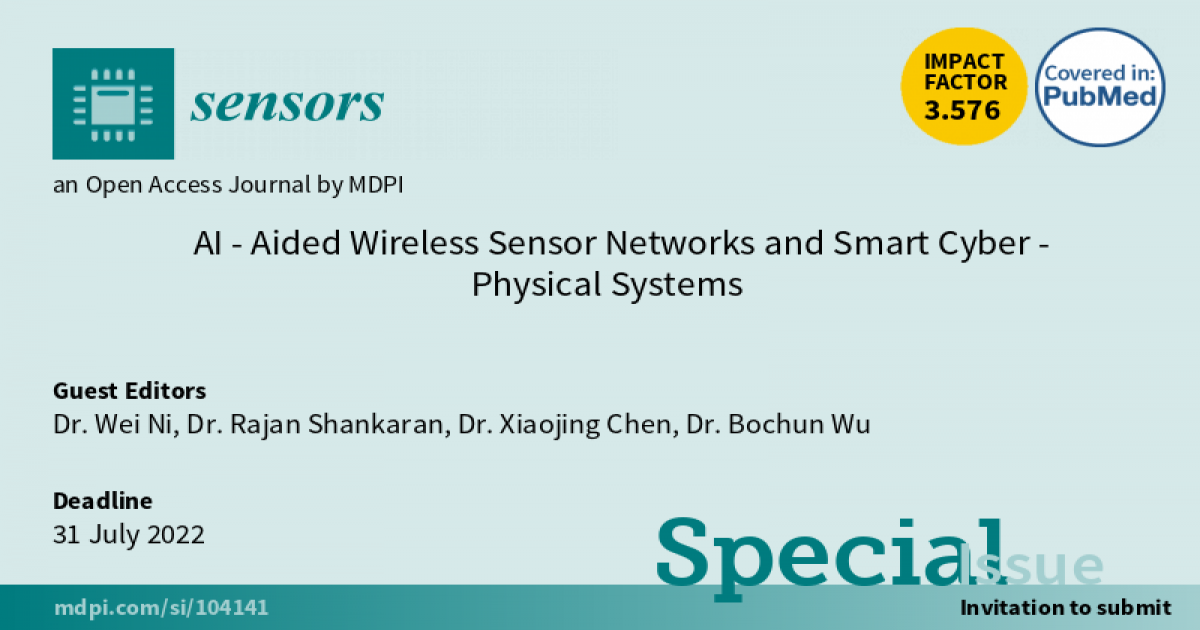AI-Aided Wireless Sensor Networks and Smart Cyber-Physical Systems
A special issue of Sensors (ISSN 1424-8220). This special issue belongs to the section "Sensor Networks".
Deadline for manuscript submissions: closed (31 July 2022) | Viewed by 38843

Special Issue Editors
Interests: signal processing; communication network; security
Special Issues, Collections and Topics in MDPI journals
Interests: wireless and mobile networks security; sensor networks security; QoS and energy-aware routing; cognitive radio networks; security in mobile ad hoc networks; denial of service attacks in Internet of Things; trust management in ad hoc/sensor networks; key management in ad hoc/sensor networks
Special Issues, Collections and Topics in MDPI journals
Interests: green communications; edge computing, stochastic network optimization
Special Issues, Collections and Topics in MDPI journals
2. Key Laboratory of EMW Information (MoE), Fudan University, Shanghai 200433, China
Interests: IoT/IoV; HetNet; MEC; UAV; resource allocation; machine learning
Special Issues, Collections and Topics in MDPI journals
Special Issue Information
Dear Colleagues,
As part of modern communication technologies, a variety of sensors are deployed to exchange data between the physical and cyber worlds. In the age of 5G, wireless sensor networks (WSNs) promise to overturn human–machine interactive styles in Internet-of-Things (IoT) and Internet-of-Vehicles (IoV) industries. The integrity of WSN and emerging technologies, e.g., AI, edge computing, unmanned aerial vehicles (UAV), intelligent buildings, and smart grids, has also enabled new mobile applications, such as virtual reality (VR)/augmented reality (AR), holographic telemedicine, autonomous driving, indoor localization, and crowd behavior identification. On the other hand, cyber–physical systems (CPSs) feature tight coordination between computations and controls via networking communications. However, constructing a paradigm to improve physical–cyber coordination in communications, controls, and computations remains unexplored. Detailed studies of WSNs and CPSs will significantly contribute to developing 5G/AI networking technologies.
This Special Issue, entitled “AI-aided Wireless Sensor Networks and Smart Cyber-Physical Systems”, is addressed to adopt AI-based schemes to solve wireless communication problems in WSN and CPS and to study all types of AI-based sensing and networking applications.
Topics of interest include, but are not limited to:
- Communications, controls, and computations in WSN and CPS;
- Security in WSN and CPS;
- Machine learning-aided WSN and CPS;
- UAV-aided WSN and CPS;
- Multi-agent coordination and combinatorial/distributed decisions in CPS
- Edge/fog/cloud computing in WSN and CPS;
- Applications of WSN and CPS;
- Other emerging subjects of WSN and CPS
Dr. Wei Ni
Dr. Rajan Shankaran
Dr. Xiaojing Chen
Dr. Bochun Wu
Guest Editors
Manuscript Submission Information
Manuscripts should be submitted online at www.mdpi.com by registering and logging in to this website. Once you are registered, click here to go to the submission form. Manuscripts can be submitted until the deadline. All submissions that pass pre-check are peer-reviewed. Accepted papers will be published continuously in the journal (as soon as accepted) and will be listed together on the special issue website. Research articles, review articles as well as short communications are invited. For planned papers, a title and short abstract (about 100 words) can be sent to the Editorial Office for announcement on this website.
Submitted manuscripts should not have been published previously, nor be under consideration for publication elsewhere (except conference proceedings papers). All manuscripts are thoroughly refereed through a single-blind peer-review process. A guide for authors and other relevant information for submission of manuscripts is available on the Instructions for Authors page. Sensors is an international peer-reviewed open access semimonthly journal published by MDPI.
Please visit the Instructions for Authors page before submitting a manuscript. The Article Processing Charge (APC) for publication in this open access journal is 2600 CHF (Swiss Francs). Submitted papers should be well formatted and use good English. Authors may use MDPI's English editing service prior to publication or during author revisions.
Keywords
- wireless sensor networks
- cyber-physical systems
- AI
- IoT/IoV
- security
- UAV
- smart grids
- intelligent buildings
Benefits of Publishing in a Special Issue
- Ease of navigation: Grouping papers by topic helps scholars navigate broad scope journals more efficiently.
- Greater discoverability: Special Issues support the reach and impact of scientific research. Articles in Special Issues are more discoverable and cited more frequently.
- Expansion of research network: Special Issues facilitate connections among authors, fostering scientific collaborations.
- External promotion: Articles in Special Issues are often promoted through the journal's social media, increasing their visibility.
- e-Book format: Special Issues with more than 10 articles can be published as dedicated e-books, ensuring wide and rapid dissemination.
Further information on MDPI's Special Issue polices can be found here.








